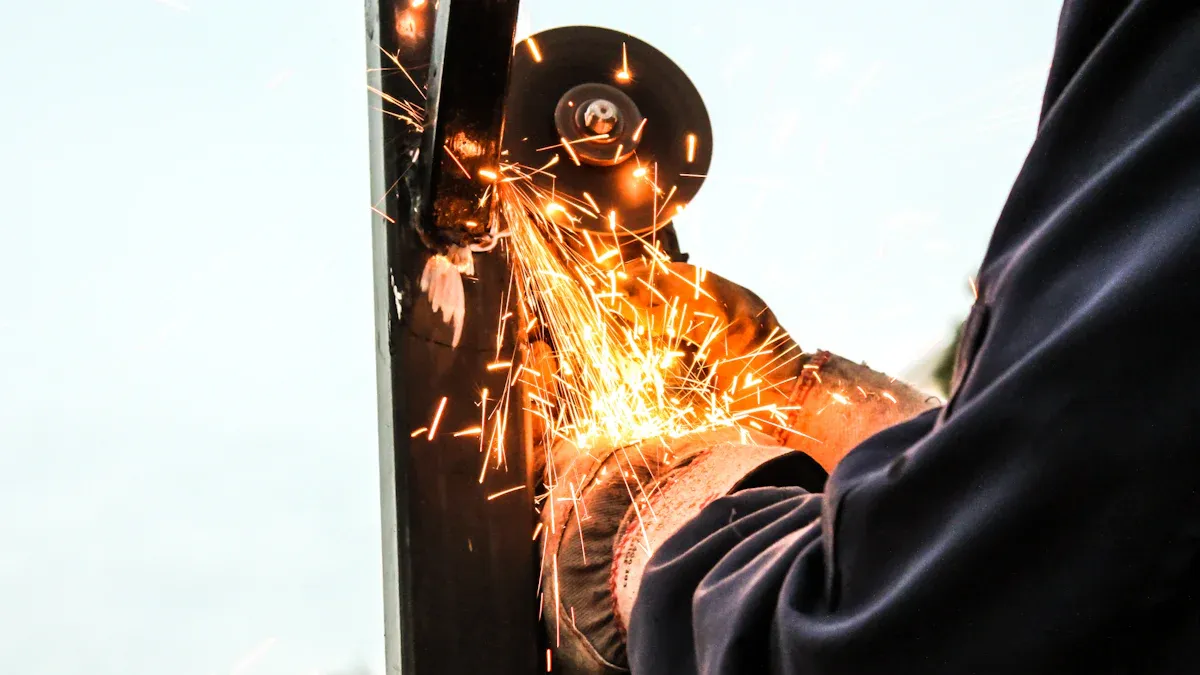
Taking care of a household electric donut maker isn’t just about keeping it clean—it’s about ensuring safety and better-tasting donuts. Regular maintenance helps the machine work smoothly and last longer. Neglecting it can lead to uneven heating or even electrical issues. A little effort now can save money and frustration later.
Key Takeaways
- Taking care of your donut maker keeps it safe and makes better donuts. Small steps now can save money on repairs later.
- Always unplug the donut maker before cleaning it. Use a soft cloth and gentle soap to protect the non-stick coating.
- Keep your donut maker in a cool, dry spot to stop rust and damage. Check it often for problems so you can fix them early.
Understanding Your Household Electric Donut Maker
Key Components Explained
A household electric donut maker might look simple, but it has several important parts that work together to create those delicious treats. First, there’s the heating plate, which ensures the batter cooks evenly. This is where the magic happens. Most models have a non-stick surface to make removing donuts easier and cleaning less of a hassle.
Next, the temperature control system plays a key role. It keeps the heat consistent, so your donuts don’t end up overcooked or undercooked. Some machines even have indicator lights to let you know when they’re ready to use. Lastly, the power cord and plug are essential for safe operation. Always check these for any signs of wear or damage.
Understanding these components helps you care for your machine better and troubleshoot small issues before they become big problems.
Safety Tips for Handling and Maintenance
Safety should always come first when using your household electric donut maker. Start by unplugging the machine before cleaning or inspecting it. This prevents accidental shocks. Let the device cool completely before touching the heating plate. Even a quick touch can cause burns if it’s still hot.
When cleaning, avoid using sharp tools or abrasive sponges. These can scratch the non-stick surface, making it less effective over time. Instead, use a soft cloth or sponge with mild soap. Also, keep the power cord away from water to avoid electrical hazards.
Finally, store the donut maker in a dry, cool place. Avoid stacking heavy items on top of it, as this could damage the heating plate or other components. A little caution goes a long way in keeping your machine safe and functional.
Daily Maintenance Routine

Cleaning Steps After Each Use
Keeping your household electric donut maker clean after every use is the first step to maintaining its performance. Start by unplugging the machine and letting it cool completely. Once it’s safe to handle, wipe the heating plate with a damp cloth or sponge. A mild soap solution works best for removing grease and crumbs. Avoid soaking the machine or letting water touch the electrical components.
For stubborn residue, use a soft-bristled brush to gently scrub the non-stick surface. Never use sharp tools or abrasive cleaners, as they can damage the coating. If your donut maker has removable parts, check the user manual for instructions on cleaning them separately.
Maintaining oil quality is also crucial for better-tasting donuts and a longer-lasting appliance. Use high-quality oil and monitor its condition regularly. Filtering the oil to remove debris enhances flavor and prevents buildup on the heating plate. Always keep the oil level within the recommended range to ensure even cooking and avoid spills.
Tip: Clean the machine immediately after use to prevent residue from hardening. This makes the process quicker and easier.
Best Practices for Storage
Proper storage keeps your household electric donut maker safe and ready for its next use. Before storing, ensure the machine is completely dry to prevent rust or mold. Wrap the power cord neatly to avoid tangling or damage.
Choose a cool, dry place for storage. Avoid areas with high humidity, as moisture can affect the electrical components. If possible, store the donut maker in its original box or a protective cover to shield it from dust and scratches.
Stacking heavy items on top of the machine is a common mistake. This can warp the heating plate or damage the temperature control system. Instead, designate a specific spot in your kitchen cabinet or pantry for the appliance.
Note: Regularly inspect the machine during storage for signs of wear or damage. Early detection can save you from costly repairs later.
Weekly and Monthly Maintenance
Deep Cleaning Methods
Deep cleaning keeps your household electric donut maker in top shape. Start by unplugging the machine and letting it cool completely. Once it’s safe to handle, remove any detachable parts, like drip trays or batter overflow guards, if your model has them. Wash these parts with warm, soapy water and dry them thoroughly.
For the non-stick heating plates, use a soft cloth or sponge to wipe away grease and crumbs. A mixture of baking soda and water works wonders for stubborn stains. Apply it gently, let it sit for a few minutes, and then wipe it clean. Avoid using metal tools or abrasive cleaners, as they can damage the surface.
Tip: Use a cotton swab to clean hard-to-reach corners or crevices. This ensures no residue gets left behind.
Inspecting for Damage or Wear
Regular inspections help catch small issues before they become big problems. Check the non-stick coating for scratches or peeling. If the coating is damaged, it may affect the quality of your donuts and make cleaning harder.
Examine the power cord for fraying or exposed wires. Damaged cords can pose safety risks and should be replaced immediately. Also, inspect the hinges and locking mechanisms to ensure they’re functioning properly. Loose or broken parts can affect the machine’s performance.
Note: If you notice any unusual sounds or smells during operation, stop using the machine and consult the user manual or a professional technician.
Checking Electrical Parts and Connections
The electrical components of your household electric donut maker need occasional attention. Begin by inspecting the plug and cord for any visible damage. A loose or bent prong can cause power issues.
Test the temperature control system by running the machine empty for a few minutes. If the heating plates don’t warm up evenly, the thermostat might need adjustment or replacement. Also, check the indicator lights to ensure they’re working correctly.
Caution: Never attempt to open the machine’s internal components unless you’re trained to do so. For complex electrical repairs, always contact a professional.
Troubleshooting Your Household Electric Donut Maker

Even with regular maintenance, your household electric donut maker might occasionally run into issues. Don’t worry—most problems are easy to fix with a little know-how. Let’s dive into some common troubleshooting tips.
Fixing Uneven Heating
Uneven heating can ruin your donuts, leaving some undercooked and others overdone. If this happens, start by checking the heating plates. Grease or residue buildup can block heat distribution. Use a damp cloth to clean the plates thoroughly. For stubborn spots, a paste of baking soda and water can help.
If cleaning doesn’t solve the problem, test the temperature control system. Plug in the machine and let it preheat. Place a small amount of batter on different sections of the plate. Uneven cooking might indicate a faulty thermostat. In this case, consult the user manual or contact the manufacturer for repairs.
Tip: Always preheat your donut maker before adding batter. This ensures the heat is evenly distributed from the start.
Removing Stuck Residue
Stuck residue can make cleaning a nightmare and affect the taste of your donuts. To remove it, unplug the machine and let it cool completely. Then, dampen a soft cloth with warm, soapy water and gently wipe the non-stick surface. Avoid scrubbing too hard, as this can damage the coating.
For tougher residue, try this trick: mix equal parts vinegar and water, then apply it to the sticky area. Let it sit for a few minutes before wiping it away. A soft-bristled brush can also help loosen stubborn bits without scratching the surface.
Caution: Never use metal tools or knives to scrape off residue. These can permanently damage the non-stick coating.
Resolving Power Issues
If your household electric donut maker won’t turn on, the issue might be with the power supply. Start by checking the outlet. Plug in another appliance to see if it works. If the outlet is fine, inspect the power cord and plug for visible damage. Frayed wires or bent prongs can prevent the machine from receiving power.
Sometimes, the problem lies inside the machine. A blown fuse or loose internal connection could be the culprit. However, opening the appliance yourself can void the warranty or cause further damage. It’s best to contact a professional technician for electrical repairs.
Note: If your donut maker frequently trips your circuit breaker, it might be drawing too much power. Consider using a different outlet or consulting an electrician.
By following these troubleshooting steps, you can keep your donut maker running smoothly and enjoy perfectly cooked treats every time.
Consistent maintenance keeps your donut maker safe, efficient, and long-lasting. Studies show that 43% of breakdowns result from neglect, while proactive care extends lifespan by 40%.
| Statistic/Insight | Impact on Electric Donut Makers |
|---|---|
| 43% of equipment breakdowns stem from improper care | Highlights the importance of maintenance for safety |
| Proactive care extends equipment lifespan by up to 40% | Indicates long-term operational benefits |
| Daily routines prevent 80% of common operational issues | Shows how maintenance enhances performance |
By adopting these simple routines, users can enjoy better results and fewer frustrations. Proper care ensures every batch of donuts is as delightful as the first.
FAQ
How often should I clean my donut maker?
Clean it after every use. Wipe the heating plates and remove crumbs to prevent buildup. Regular cleaning keeps the machine working efficiently and ensures better-tasting donuts.
Can I use metal tools to clean stuck residue?
No, avoid metal tools. They scratch the non-stick surface. Use a soft cloth, baking soda paste, or a soft-bristled brush for stubborn residue.
Tip: Vinegar and water work wonders for sticky spots!
What should I do if my donut maker stops heating?
Check the power cord and plug for damage. Test the outlet with another device. If the issue persists, contact a technician for repairs.
Note: Never open the machine yourself—it could void the warranty!

